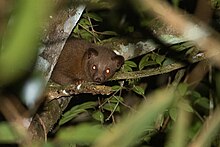Golden palm civet
| Golden palm civet[1] | |
|---|---|

| |
| Conservation status | |
| Scientific classification | |
| Kingdom: | Animalia |
| Phylum: | Chordata |
| Class: | Mammalia |
| Order: | Carnivora |
| Family: | Viverridae |
| Genus: | 'Paradoxurus' |
| Species: | ''P. zeylonensis'' |
| Binomial name | |
| Paradoxurus zeylonensis | |

| |
| Golden palm civet range | |
The golden palm civet (Paradoxurus zeylonensis) is a palm civet endemic to Sri Lanka. It is listed as Vulnerable by IUCN because it occurs in less than 20,000 km2 (7,700 sq mi), its distribution is severely fragmented, and the extent and quality of its habitat in Sri Lanka's hill regions are declining.[2]
Characteristics
[edit]The golden palm civet is brown on the upper side, but individually variable from dark sepia to ochreous, rusty or golden-brown. The tips of the contour hairs are frequently lustrous, sometimes greyish. The legs are about the same tint as the back, but the tail and the face are sometimes noticeably paler, buffy-grey. The face does not have a pattern, and the vibrissae are dirty white. The hair in front of the shoulders radiates from two whorls and grows forward along the sides of the neck and the nape to the head. It also grows forward on the fore throat, radiating from a single whorl. The dorsal pattern consists of faint bands and spots that are slightly darker than the ground colour. The lower side is slightly paler and sometimes greyer than the upper.[4]
The golden palm civet has two morphs — one golden and one dark brown, both of which are recorded from Sri Lanka. In 2009, several museum specimens were studied, and on this basis it was suggested to split these color morphs into separate species:[3]
- the golden wet-zone palm civet Paradoxurus aureus,
- the Sri Lankan brown palm civet Paradoxurus montanus, and
- the golden dry-zone palm civet Paradoxurus stenocephalus.
Distribution and habitat
[edit]The golden palm civet is found in lowland rain forest, evergreen mountain forests, and also dense monsoon forest.[5]
Ecology and behaviour
[edit]The golden palm civet is forest-dependent, yet tolerant of minor habitat modification where some continuous forest remains. It is arboreal, nocturnal, and solitary; its diet consists of fruits, berries, invertebrates, and a wide range of small vertebrates.[2]
In culture
[edit]In Sri Lanka the golden palm civet is called Pani uguduwa පැනි උගුඩුවා, Sapumal kalawaddhaසපුමල් කලවැද්දා, or Ranhothambuwa රන් හොතබුවා/Hotambuwa හොතබුවා, by the Sinhala speaking community. Both golden and Asian palm civet are sometimes collectively called kalawedda in Sinhala and maranai (மரநாய்) in Tamil.[3]
However, the term Hotambuwa is mostly used to refer altogether a different species Ruddy Mongoose (Herpestes smithii). Due to similar appearance and coloration, they are mistaken as the same animal.
This civet appears in 3 rupee Sri Lankan postal stamp.[6] However, it is named as 'Golden Palm Cat' in the stamp.
References
[edit]- ^ Template:MSW3 Wozencraft
- ^ Jump up to: a b c Template:IUCN
- ^ Jump up to: a b c Groves, C. P.; Rajapaksha, C.; Manemandra-Arachchi, K. (2009). "The taxonomy of the endemic golden palm civet of Sri Lanka" (PDF). Zoological Journal of the Linnean Society. 155: 238–251. doi:10.1111/j.1096-3642.2008.00451.x.
- ^ Pocock, R. I. (1939). The fauna of British India, including Ceylon and Burma. Mammalia. – Volume 1. Taylor and Francis, London. Pp. 381–383.
- ^ Schreiber, A., Wirth, R., Riffel, M. and Van Rompaey, H. (1989). Weasels, civets, mongooses, and their relatives. An Action Plan for the conservation of mustelids and viverrids. IUCN, Gland, Switzerland.
- ^ Golden Palm Cat Stamp

